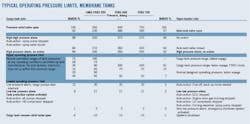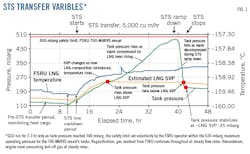LNG CARGO HANDLING-1: New approach improves ship-to-ship LNG transfers
Maksym Kulitsa
FSRU consultant
Odessa, Ukraine
David A. Wood
DWA Energy Ltd.
Lincoln, UK
A new approach to LNG cargo management during ship-to-ship (STS) transfers focuses on optimizing tank-pressure monitoring and control. The concept is primarily developed for STS transfers between LNG marine carriers (LNGC) and floating storage and regasification units (FSRU), but some of its components are also relevant to STS transfers from LNGC to LNGC. The new concept is consistent with the physical properties of LNG, its volatility (rapid transitions between liquid and vapor depending upon conditions), relationships between prevailing tank pressures and the LNG's saturated vapor pressure (SVP), the influence of surface evaporation on liquid and vapor phase behavior in LNG tanks, and the general thermodynamic behavior of LNG.
This article focuses on practical implementation of the approach and consequences associated with its components to save LNG cargo from unnecessary loss during various STS operations. Each tonne of cargo-loss avoided is equivalent to a cost saved of $369 when 1 million btu of gas can be sold at $7 based on the gross heating value (GHV) of methane being 0.0527 MMbtu/kg.
Several potential optimization measures can be applied during STS transfers to minimize avoidable cargo losses. Each measure is limited in its efficiency-with a range of incremental positive effects-if undertaken alone. When all or most of these measures are applied at once, however, significant positive economic effects can be achieved without compromising safety on either the FSRU or LNGC.
Part 1 of this article, presented here, describes seven such measures (see accompanying box) individually. Part 2 will present five more as well as a strategy for applying them collectively. Each measure first is explained for LNGC-to-FSRU cargo transfers, with additional comments added for LNGC-to-LNGC transfers.
Cold cargo requirement
Many shore-based receiving terminals require LNGC to arrive with cargoes that are below specified upper temperature limits or with SVP below specified values. FSRU may apply similar specifications when agreeing to purchase LNG cargoes, which can be particularly beneficial for 250-mbarg maximum allowable relief valve setting (MARVS) FSRU, depending on whether the cargo was purchased free-on-board (FOB) at the port of loading or delivered ex-ship (DES) at the point of STS transfer.
Although the negotiation of these specifications is beyond the scope of FSRU and LNGC on-board operators, it is important that LNG owners and charterers are aware of the consequences of insufficiently cold LNG during STS transfers. LNG typically warms by about 0.6-1.0° C. during STS as it passes through cargo transfer pipes. This warming increases the LNG's SVP by 60-100 mbar when reaching FSRU tanks. A rule of thumb is that a 0.1° C. liquid temperature increase causes SVP to rise by about 10 mbar for all commercial LNG grades. SVP increase is exacerbated if the LNG arriving in the LNGC is already warmer than it should be.
Such LNG temperature increases during STS transfers are more important for FSRU with 250 mbarg MARVS (or receiving LNGC with 250 mbarg MARVS) than for FSRU with higher tank-pressure tolerances. The colder the LNG transferred, the less boil-off gas (BOG) will be consumed in the FSRU's gas combustion unit (GCU)-steam dump. Faster STS transfer rates are preferable to slower STS rates because of their lower increases in temperature.
Typical STS transfer rates are 5,000-6,000 cu m/hr. At faster rates (e.g., 9,000 cu m/hr) LNG is loaded to a 250-mbarg MARVS FSRU with maximum tank pressures reaching 180-190 mbarg during the transfer if no optimization measures are taken, but significant loss of cargo in GCU or steam dump. Loading a colder cargo (one with lower SVP) indirectly leads to less GCU-steam dump consumption.
Pre-STS FSRU tank pressure
FSRU should strive to achieve minimum LNG tank pressures at the start of STS transfers to allow for greater potential pressure increases during the transfer. This approach also can delay an FSRU (or receiving LNGC) activating tank pressure control via GCU or steam dump, indirectly leading to less total LNG cargo consumption.
The common practice of using a specified tank pressure as reference (e.g. 100 mbarg) is unjustified and counterproductive in terms of saving cargo from loss. FSRU designs and their associated BOG-handling equipment typically perform well at minimum tank pressures of 50-80 mbarg (see accompanying table). The lowest tank pressure at which BOG-handling equipment can operate effectively at a given load is in practical terms its lowest operating pressure and should be a target pressure established immediately before the lines-cooldown phase of STS transfer. This lowest operating pressure can differ between steam-turbine and dual-fuel diesel electric (DFDE) ships and vary with prevailing load on the BOG handling equipment.
Achieving pressures close to the lower-pressure limit is not difficult as, usually, before an STS transfer begins, the FSRU will have low or medium cargo stock (LNG heel) on board. This heel can be efficiently cooled to near its lower-pressure limit naturally during regasification. It is important to avoid using the GCU or steam dump to lower the pressure as it will lead to much higher total LNG losses before and during STS transfer despite reducing pressure and consumption in the transfer's wake.
If the low-target tank pressure cannot be reached naturally, it is better to start an STS transfer at a pressure that can be naturally sustained based on prevailing engine-room consumption, regasification, and recondenser throughput without using GCU-steam dump, even if this pressure is much higher than the target pressure. Doing so will lead to smaller BOG consumption in the GCU-steam dump equipment before and during STS operation, reducing cargo loss.
The primary obstacle to reaching suitably low pressure is excessive recirculation through the regasification plant feed pumps in FSRU cargo tanks. Such recirculation works against cooling and should be avoided until necessary. The regasification rate requirement takes priority over achieving any given target pressure. Starting extra feed pumps for recirculation should only occur to stabilize other pumps that become unstable at very low tank levels.
It is usually easy to cool an LNG cargo after STS transfer, if necessary, because the LNG heel is typically minimal. FSRU must carefully manage LNG rollovers to avoid them shortly before STS transfer begins. Failing to do so leaves insufficient time for cargo cooling and makes reaching the lowest tank pressures unlikely, even when operating GCU or steam dump equipment. Even in such cases, however, it is often still not beneficial to run GCU or steam dump equipment to reduce tank pressure before an STS unless not doing so will cause post-rollover tank pressure to move outside safe operating ranges.
Rollovers on FSRU can be managed effectively to allow sufficient time for cargo heel to cool before STS transfer. Rollover management, however, is out of the scope of this article and is specifically addressed elsewhere (OGJ, June 5, 2017, pp. 74-81).
GCU, steam dump use before STS
Due to the specific relationship between actual tank pressure and LNG SVP, energy required to cool the LNG cargo before STS transfers consumes much more gas than tank-pressure control during STS. For this reason, the LNG heel should be cooled exclusively using regasification, recondenser, a latent heat capture system (LHCS), or similar systems by running them at maximum possible rates before STS. Beginning STS transfers with low FSRU tank pressures sometimes makes it possible to complete the transfer without running the GCU or steam dump equipment at all, particularly on FSRU with higher MARVS.
In practice, an operator often cannot know for sure in advance if it will need to run GCU-steam dump equipment during a STS transfer. Acting in advance by electing to run the GCU-steam dump may cause all the gas consumption associated with that equipment to be a pure loss, because tank pressure might not reach its upper limit during the pending transfer even without GCU-steam dump use. Addressing tank-pressure control by running GCU-steam dump equipment is best done only when high tank pressures occur, and not in advance. The same is true for the receiving ship in LNGC-to-LNGC transfers.
An observed case involving use of the GCU to knock down tank pressure before STS transfer consumed 237 tons of cargo as BOG and 3.5 tons during STS transfer for tank-pressure control. If tank pressure had been allowed to remain high, without running the GCU before transfer, gas consumption would have reached a maximum of 80-100 tons of BOG during the STS transfer for tank-pressure control but none before the transfer began.
Cool complete tank structure
The tank structure around the vapor space should be at minimum achievable temperatures before STS transfer begins. The part of the tank containing vapor is inevitably much warmer than the LNG. During STS transfer, once this part of tank is submerged in LNG, the LNG will be heated as the tank cools. If the tank structure is already at a low temperature then LNG heating is less, indirectly helping minimize BOG consumption for tank-pressure-control in the GCU or steam dump.
This benefit can be attained by top spraying tanks even if there is a significant LNG heel cargo volume. Top spraying is prudent if conducted at very slow rates for a long time, 24-48 hrs, before STS transfer. Doing so generates minimum extra vapor during cooling of the tank structure and can be easily managed by normal BOG handling equipment.
Many FSRU have a pump-discharge column-spraying capability that helps cool the vapor space. But this technique is much less effective in cooling the whole tank structure, surrounding only the vapor space above the liquid level, than top spraying across the whole tank.
An additional benefit of precooling a tank's vapor space is the avoidance of cold vapor generated during STS transfer that would be heated by the warm tank structure and volumetrically expand, further increasing tank pressure. To minimize incremental pressure increases during STS transfer the whole tank structure surrounding the vapor space should be cooled as much as it realistically can be using planned, slow, top spraying before STS transfer. An ideal outcome is for the tank vapor temperature to be about that of the LNG heel cargo, and for the tank barrier's temperature to remain stable at the coldest achievable state before STS transfer begins.
Top spraying a cold tank causes some evaporation mass as vapor forms from the liquid spray droplets. This mass is typically less than 10% of sprayed mass and declines as the tank's structure become progressively colder.
Tank pressure rise, line cooldown
During STS transfers the cooling of the LNG transfer lines typically involves flow directed from the discharging LNGC towards the FSRU or receiving LNGC. This transfer-line cooldown sends a significant volume of heated and expanded vapor to the FSRU. This vapor can cause FSRU tank pressure to rise by 50-60 mbar or more if the generated vapor from the transfer lines is injected directly into vapor spaces in the receiving vessel's tanks. It is therefore prudent to inject such vapor directly into the LNG cargo heel at the bottom of the FSRU's tanks, causing a significant portion of the vapor to condense within the heel depending on its size.
This injection needs to be performed cautiously to avoid causing suction disturbances at the regasification plant's feed pumps. If possible, it is better to distribute the incoming vapor between all tanks to minimize the volume entering any individual tank.
Alternatively, it is most effective to direct that vapor to the tanks with the largest LNG heel, avoiding tanks where the LNG heel cargo is very small (measured by height).
The cooldown of two 800-m steel transfer lines induced a tank pressure rise of 20-30 mbarg when injecting generated vapor directly into the LNG cargo heel for 1 hr. Side-to-side STS transfers with flexible transfer lines or cross-dock STS transfers would further reduce pressure increases. When using longer lines in warmer atmospheric conditions, however, this optimization measure can avoid more significant FSRU tank pressure increases. In the case of a receiving LNGC in LNGC-to-LNGC transfers the very small cargo heel reduces this measure's effectiveness, but it still might be beneficial.
Maintaining cold temperatures
Establishing a minimum level of top spraying in the FSRU's tanks as a STS progresses is effective because it maintains the entire tank structure in a cooler state than would be the case without such an action. This at least partially compensates for the relatively rapid heating of the vapor space in the tank that was very cold prior to STS. Continuing with a minimum top spraying rate prevents expansion of cold tank vapor and keeps the tank's structure cold during the STS transfer.
The amount of extra boil-off generated by top spraying will vary depending on how much the tank's vapor space decreases during STS transfer, the maximum extra BOG being estimated at less than 8-10% of the sprayed LNG mass. It is a misconception that top spray always generates significant boil off gas. In warm tanks it does; in very cold tanks it does not.
In very cold tanks the top spray essentially remains as "LNG rain," and the evaporation of spray droplets (i.e., vapor formation) slows sharply once the gas in the vapor space is below the natural gas dew point temperature, typically -145° C. to -150° C. Volumetric expansion of cold vapor due to natural heating increases tank pressure much more than top spray evaporation in cold tanks.
Top spraying could be stopped close to the end of an STS operation, when the LNG level in the tank is high and the tank's vapor space is relatively small. It is best to stop top spraying immediately before STS transfer begins its ramp-down phase. In some cases, however, it is beneficial to continue top spraying on the receiving vessel until STS ends.
If top spraying is terminated mid-STS transfer (when the vapor space is still large) then volumetric heated expansion of the vapor will increase tank pressure. Delaying the start of top spraying during STS transfer could be beneficial if the tank structure surrounding the vapor space is not warm relative to the natural gas's dew point.
Pressure control, GCU-steam dump
A sensible FSRU tank-pressure management strategy is to exploit the tank's entire operating pressure range as defined by its manufacturer (250-mbarg MARVS usually apply 180-200 mbarg as an upper operating limit; 700-mbarg MARVS, 640-mbarg limits, see table). This strategy allows tank pressure to rise-if operations such as STS transfers cause it to do so (Fig. 1)-until it approaches the tank's upper operating-pressure limit, at which point cargo safety equipment (GCU, steam dump, etc.) is activated to hold tank pressure at or immediately below pressure limit. In this way, safety equipment is only activated for immediate safety reasons and any gas consumption relating to its use is not considered a loss.
With pressure fully controlled within the permitted operating range of a tank, risks remain well within tolerance limits, allowing pressure to rise above the LNG's SVP. Tank pressure is controlled by GCU-steam dump equipment only when the LNG has reached a physical state referred to as pressure subcooled. Generation of new boil off in this state remains below the normal rate, even approaching zero depending on the degree to which tank pressure exceeds the LNG's SVP (Fig. 1-2).
Unlike Fig. 1, in Fig. 2 there is no ongoing STS transfer. But interruption of regasification operations and consequential shutdown of the recondenser reduce BOG consumption in the FSRU engine room inevitably leading to a return of excess BOG, or "packing," from the low duty compressor to the tank, causing tank pressure to rise rapidly. When regasification resumes depacking of the tank's vapor space occurs rapidly.
Figs. 1 and 2 clearly display a tank with dual-type behavior when vapor is in contact with the LNG. As tank pressure rises above LNG SVP, BOG generation drops sharply or even ceases. It is possible to control tank pressure effectively even with the relatively much smaller quantities of BOG extracted from the tank.
This is only applicable when tank pressure is above the LNG's SVP. When tank pressure is the same as SVP or dynamically stabilized just below SVP a different boil-off regime prevails and BOG emissions occur in normal or large quantities. With tank pressures dynamically stabilized just below SVP, typically -15 to -35 mbar in FSRU, operator actions may result in significantly boosting BOG emissions, leading to only minor changes in tank pressure as SVP changes.
The packing of vapor associated with the rising tank pressure trend occurred on average at 155 mbar/hr, which given sufficient time should have resulted in about a 1.55° C. change in LNG temperature, but did not (Fig. 2). The actual change in temperature recorded was < 0.1° C. With 75% of cargo on board the volume could not be warmed by 1.55° C. via natural heat ingress in just 4 hr. LNG temperature and SVP therefore remained essentially unchanged.
Depacking associated with the declining tank pressure trend occurred on average at 633 mbar/hr, slowing to 100 mbar/hr. But eventually the same BOG evacuation conditions resulted in tank pressure stabilizing broadly, dynamically balanced just below the LNG's SVP. Fig. 1 also depicts the dual-type behavior typically observed during STS transfer. But in that case the SVP also changes as the STS transfer progresses and a new cargo of different composition or temperature is introduced.
Measure 7 is always most effective, but has its smallest impact on 250-mbarg MARVS FSRU and its greatest impact on FSRU of 700-mbarg MARVS. Applying Measure 7 may result in the LNG becoming slightly heated during STS transfer, but this normally poses no problems as the LNG is heated in the regasification plant anyway. Measure 7 also reduces consumption of valuable cargo in GCU, steam dump, and similar equipment to the minimum necessary for safety, dropping cargo loss to near zero while guaranteeing safe tank operations and maximizing economic efficiency.
The alternative-starting safety equipment at the beginning of STS transfer-is common practice but consumes excessive gas through the GCU or steam dump. This consumption consists of both lost gas and any gas used for safety reasons, or only lost gas if safety reasons never come into play.
The safety difference between current practice and proposed optimization Measure 7 is negligible. Risks when applying Measure 7 remain within acceptable limits. Adopting such a strategy, however, requires that the GCU and steam dump equipment be maintained in a state of immediate readiness that allows quick startup in the event of unexpected events.
For transfers to another LNGC, Measure 7 is only applicable if the slightly warmed cargo is not going to cause problems for the terminal receiving it at the next point of discharge (see Measure 1). If the warmer LNG is next to be delivered to a 250-mbarg MARVS FSRU it would not be appropriate to use Measure 7.
Bibliography
International Group of Liquefied Natural Gas Importers (GIIGNL), "Rollover in LNG Storage Tanks," 2nd Ed.: 2012-2015, public version.
Hashemi, H.T. and Wesson, H.R., "Cut LNG Storage Costs," Hydrocarbon Processing, August 1971, pp. 117-120.
Kulitsa, M. and Wood, D.A., "Rigorous monitoring reduces FSRU cargo-rollover risks. Oil and Gas Journal, Vol. 115, No. 6, June 5, 2017, pp. 74-81.
Zellouf, Y. and Portannier, B., "First step in optimizing LNG storage for offshore terminals," International Gas Union Research Conference, Seoul, Oct. 19-21, 2011.
The authors
Maksym Kulitsa ([email protected]) is an independent FSRU operations consultant. with more than 8 years' experience operating various regasification systems. Kulitsa has taken a personal interest in optimizing FSRU-related operations and improving efficiency. He earned a masters degree in navigation (2006) from Odessa National Maritime Academy, Ukraine.
David A. Wood ([email protected]) is the principal consultant of DWA Energy Limited, UK, specializing in the integration of technical, economic, fiscal, risk and strategic information to aid asset and portfolio evaluations and project planning decisions. He has more than 35 years of international oil and gas experience spanning project operations, technical evaluations, research, contract negotiations, and senior corporate management. In the 1980s and 1990s he held senior technical and corporate positions with Phillips Petroleum, Amoco, Lundin Oil and Canadian independents. Since 1998 David has worked as a consultant providing evaluation, expert-witness support, and training to companies and government agencies around the world. He served as editor-in-chief of the Journal of Natural Gas Science and Engineering from 2013 to 2016.






